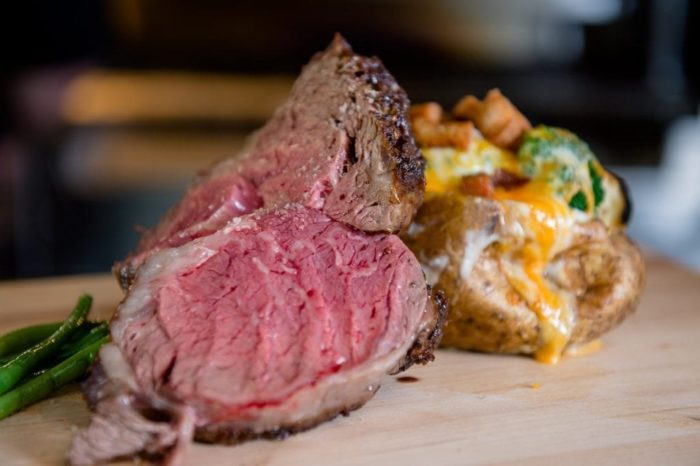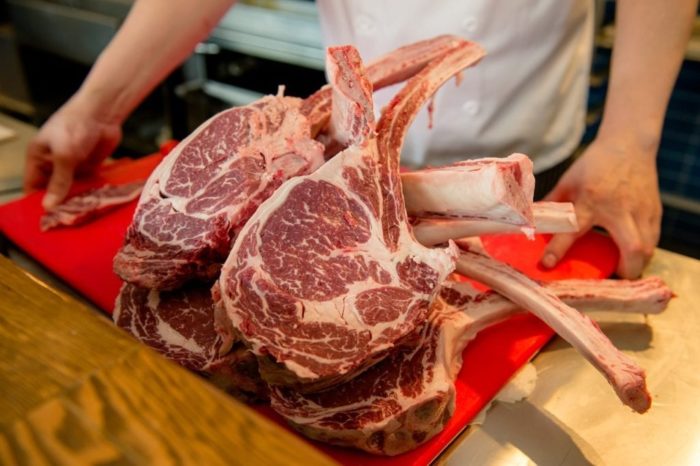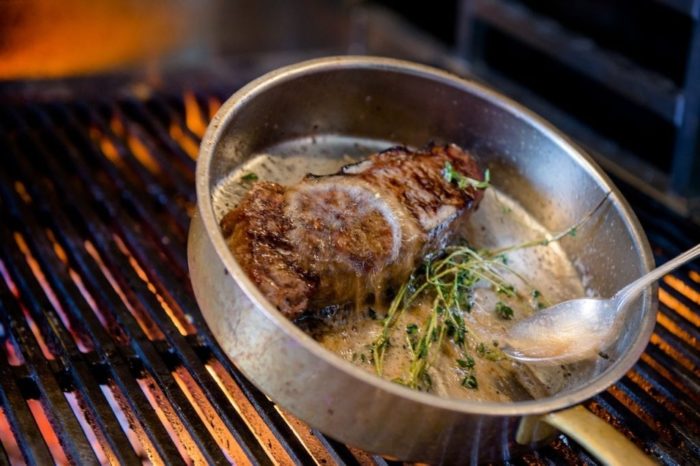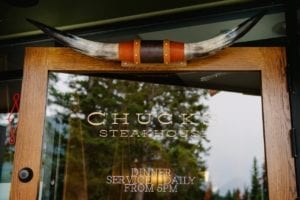The town has many steakhouses to choose from if you want anything from an open-faced steak sandwich to a premium steak. The newest, Chuck’s Steakhouse, recently joined the crowd on Banff Ave. Shortly after its opening, I spoke with owner Mike Mendelman and executive chef Sal Polizzi about what makes their beef stand out.
New Beef on the Block
Alberta is no stranger to great steak, and neither is Banff.
Why open another steakhouse in Banff?
Owner Mike Mendelman: I just didn’t think anyone was really capturing the spirit of our local cuisine, which at the end of the day is steak. I have other restaurants in Banff, and the number one question is “Do you have the local beef?” We do serve local at our other restaurants, but I wanted to bring it together as the concept: the steakhouse that captures the spirit of the Alberta steak industry in the flavours of our steak and in the atmosphere. Why Banff? Because the world is coming here to visit and I’m trying to show off the best of what we do.
What makes your steak different?
MM: We dry-age beef in-house. I think we’re the only people in Banff that are doing that.
Chef Sal Polizzi: It’s the original way of treating meat from the olden days. It slowly breaks down the enzymes and the protein inside the fat fibres. It gives the meat a nice tenderness to it and a really strong beef flavour, highlighting the true nature of the beef.
How long does this process take?
SP: You can do it as long as you want. We do it here for 35 to 45 days. You trim off the bark and cut right into it. Inside it’s a nice colour of meat and it gives it a deep flavour.
We’re trying to explore what we can do with the meat and give its characteristics to the customer. To experience the difference of a grass-fed beef or a natural-raised beef or an Alberta prime beef. You can have three different kinds of meat and each has it’s own unique characteristics to it.
Where do you get your beef?
MM: We went directly to the ranches to see who’s doing interesting things in a boutique ranch in Southern and Central Alberta. So we spent a lot of time down there and we landed on some wonderful suppliers. They are very small, but you can taste how wonderful their product is. It’s really cool to have these different ranches and to taste these different varieties of beef against each other.
SP: It’s important to us to find farmers and ranchers that do things in a sustainable way by farming in their own communities, getting the grains from their own areas and feeding healthy, natural products to the animals as well.
MM: Our land is already an advantage in southern Alberta where land, climate and geography create an amazing animal to start off with. We’re giving you the different flavours of what they can do with different style of animals. I like to look at it like how craft beer has evolved. There’s more and more craft ranching and boutique ranches and they’re doing a great job. And it’s because they get to use the world’s best climate and geography and grasslands to do it. On the other side, you don’t have much unless you’re cooking properly. We start all our steaks off on a wood-burning grill.
What does the wood-burning grill do for the beef?
SP: It gives the meat a nice light smokiness. The intense heat of the fire gives it a good sear, which seals in all the juices. It’s also a blast to cook on, and it makes it super fun.
MM: It’s the only live-fire cooked steak in Banff.
SP: So we sear it, then we let it rest for about 10 to 15 minutes on the side. We have an 1800 degree broiler, and that gives it an intense sear and then we finish it with butter. I think the whole rotation with the caramelization gives it a nice delicious flavour. People come up to me all the time and say “I didn’t know steak was supposed to taste like that.” It’s been an eye-opening experience to specialize in and be able to focus just on meat like that. This has definitely been a highlight of my career.
How has it been so far?
MM: I’m very proud of what we’ve done here. I’m proud of every plate we put in front of customers because I do think we’re giving them an honest experience of something I grew up with. My father’s name was Chuck, and he was a born and bred Albertan. Unto himself, I think he really does capture the essence of Alberta. You can see, even on our placemats, that’s my dad, his favourite horse, and a map of the cowboy trail. We’re trying to tell a story. It’s very gratifying. The consumers are overwhelmingly happy with the experience — they stay here for three plus hours. Our other dining rooms are an hour and a half, so it’s twice as long. They seem to not want to leave.





